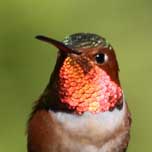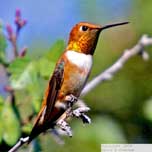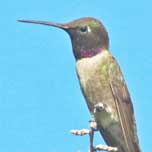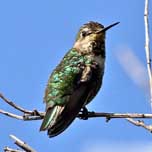
ComingsBirds.com
to the beauty of birds
Hummingbirds are birds native to the Americas and constitute the biological family Trochilidae. They are among the smallest of birds, most species measuring 3–5 in in length. Indeed, the smallest extant bird species is a hummingbird, 2.0 in bee hummingbird.
They are known as hummingbirds because of the humming sound created by their beating wings which flap at high frequencies audible to humans. They hover in mid-air at rapid wing-flapping rates, which vary from around 12 beats per second in the largest species, to in excess of 80 in some of the smallest. Of those species that have been measured in wind tunnels, their top speed exceeds 34 mph and some species can dive at speeds in excess of 49 mph.
Hummingbirds have the greatest mass-specific metabolic rate of any homeothermic animal. To conserve energy when food is scarce, and nightly when not foraging, they can go into torpor, a state similar to hibernation, slowing metabolic rate to 1/15th of its normal rate.




